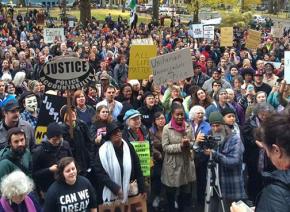Anger in the streets of Portland
writes from Portland on a spirited protest in solidarity with Ferguson.
AT LEAST 3,000 people turned out to Portland's emergency demonstration in solidarity with Ferguson after the grand jury decision not to indict Darren Wilson was announced. It was one of the most energized protests in recent years, giving those who turned out an opportunity to express their frustration with continued systemic injustice and police terrorism facing Black and Brown communities.
A rally at Portland's misnamed "Justice" Center kicked off with a roar, with mny chants heard in other Ferguson protests, such as "No justice, no peace," "Hands up! Don't shoot!" and "Whose streets? Our streets!" Signs carried by protesters included slogans like "Prosecute racist killer cops" "End the New Jim Crow" and "From Ferguson to Portland, Black Lives Matter."
After the rally, the protest stormed through Portland's streets and the heart of downtown Many onlookers cheered and waived. Drivers, some of them stopped because of the demonstration, honked their horns and cheered the protest as it passed.

This was the city's largest and most energetic march since the Occupy movement in 2011, and certainly the largest anti-racism march in recent memory. Eventually, the march found its way back to its starting point--but this proved to be only the beginning of an explosive few hours.
Some of the crowd dispersed, but a considerable number of people, numbering around 1,000, were still fired up and ready to march again. So we did just that. The march took to the streets again, this time through and against traffic. Once again, we shut down the streets of downtown Portland. The march attempted to take the Morrison Bridge, but that was blocked off by police, who began to take a more aggressive posture toward protesters.
The march carried on to Burnside Street, where protesters quickly rushed the Burnside Bridge, where there was no police presence. The bridge was shut down, as was the intersection with Martin Luther King Boulevard at the end of the bridge. Protesters then headed to the waterfront area, our numbers still strong and our resolve to see justice for Mike Brown stronger still.
The police response was one of confusion and disarray for a time. They were left tailing our energetic protest until it got to one of the ramps onto Interstate 5. There, police grew more aggressive, with numerous cops clad in riot gear. Numerous people were arrested--others were pepper-sprayed and beaten.
I want to say a few things about the police. We understand that the police will never be on our side. As an institution and as individuals, they are agents of ruling class power, and their occupation dictates what side they will represent.
Black and Brown communities see it in the form of an occupation on a daily basis. We see it in the police connections with neo-Nazi and KKK groups revealed across the country. And it's on stark display when Black and Brown people are murdered, on average, every 28 hours by a racist cop, security guard or vigilante. And we could see it in the eyes of the these agents of oppression attacking our protest.
THE DEMONSTRATION, still at between 800 to 1,000 strong, marched across and briefly shut down the Morrison Bridge--the same one they had tried to prevent us from entering in the first place. We once again marched through downtown, this time led by three young Black men. We stopped at intersections and they led us in chants. At other points, everyone fell silent, with their hands in the air, a powerful and dramatic show of solidarity with Mike Brown.
The protest gathered at PGE Park in southwest downtown Portland, where we were met with a more organized police assault. The police used sound cannons and threatened a tear gas attack--riot cops moved in and arrested dozens of people.
Eventually, the police pulled back, and the crowds thinned. I left, along with many other people. But the walk back to my car, I ran into the march once again, back to 1,000 people strong. By this time, the protest had been going on for three-and-a-half hours.
Around 400 people eventually gathered at the waterfront, and some took turns speaking. Among the main speakers were the three young men who had led the later part of the march--they expressed amazement that this was something they had "never seen in Portland before."
The speeches then turned to how to move forward. Clearly, people are both grappling with the urgency of changing this system and the need for political action and organization on a larger scale. The conclusions that some people drew reflected the disarray of the left today, after four decades of ruling class attack. The last major upsurge, the Occupy movement, was defeated in a coordinated attack by the state.
However, the lesson of Occupy was on full display--even though the movement was set back, the anger at the system and yearning for a bigger social movement is still present among many.
Now, what we need is working class political organization, rank-and-file control of our unions, and a new Black Power movement to give organizational, political and social strength to Black and Brown communities. The potential to work toward these elements of a future struggle represents a great opportunity for us.


